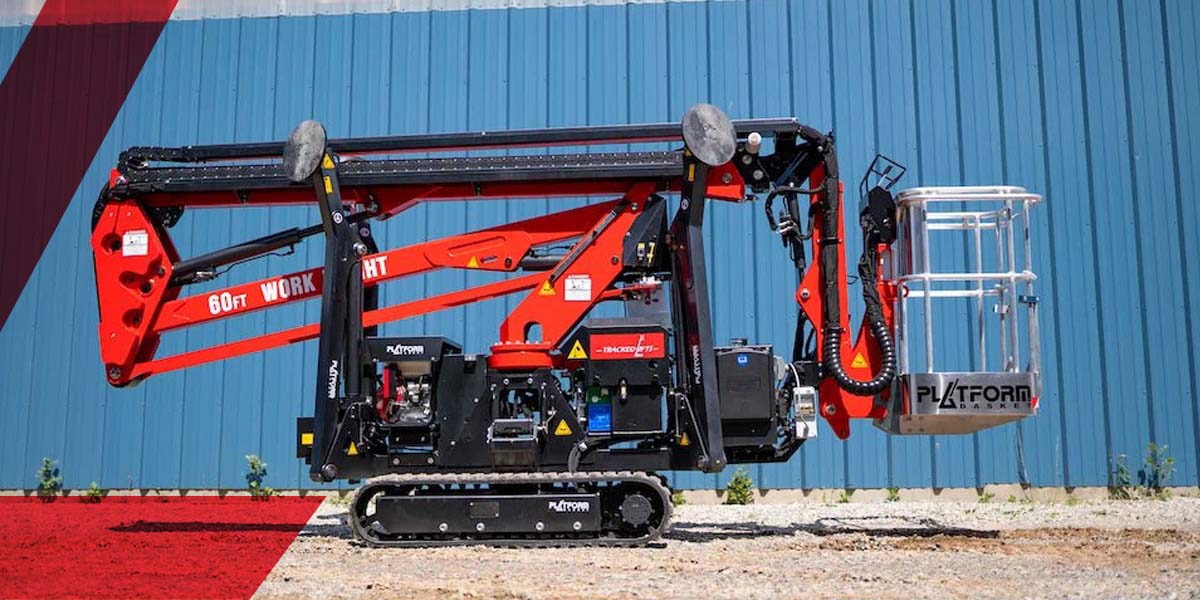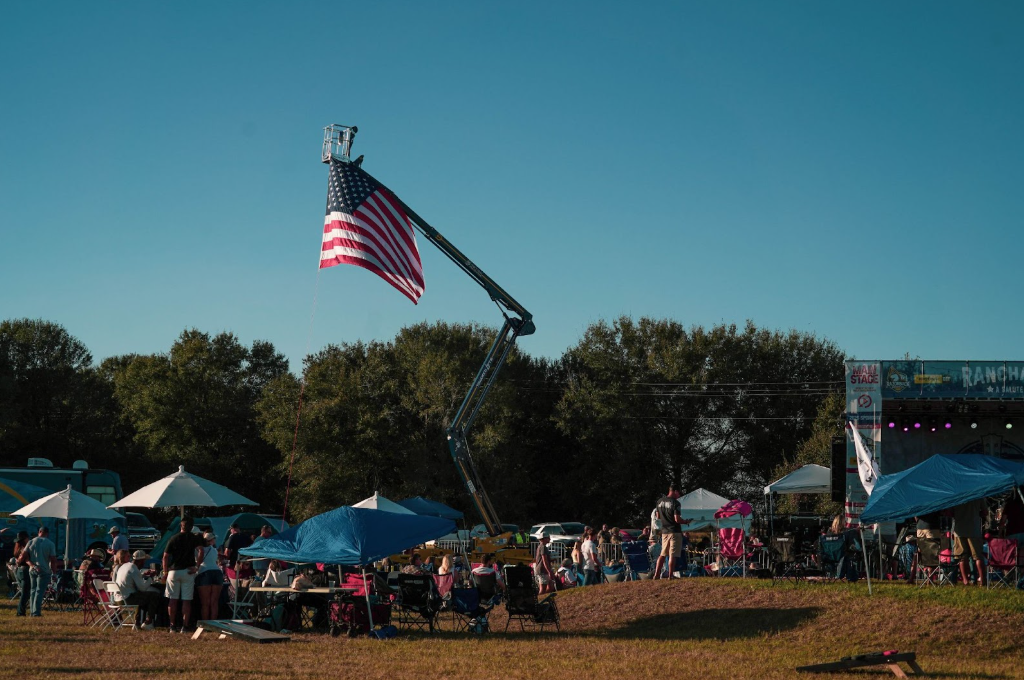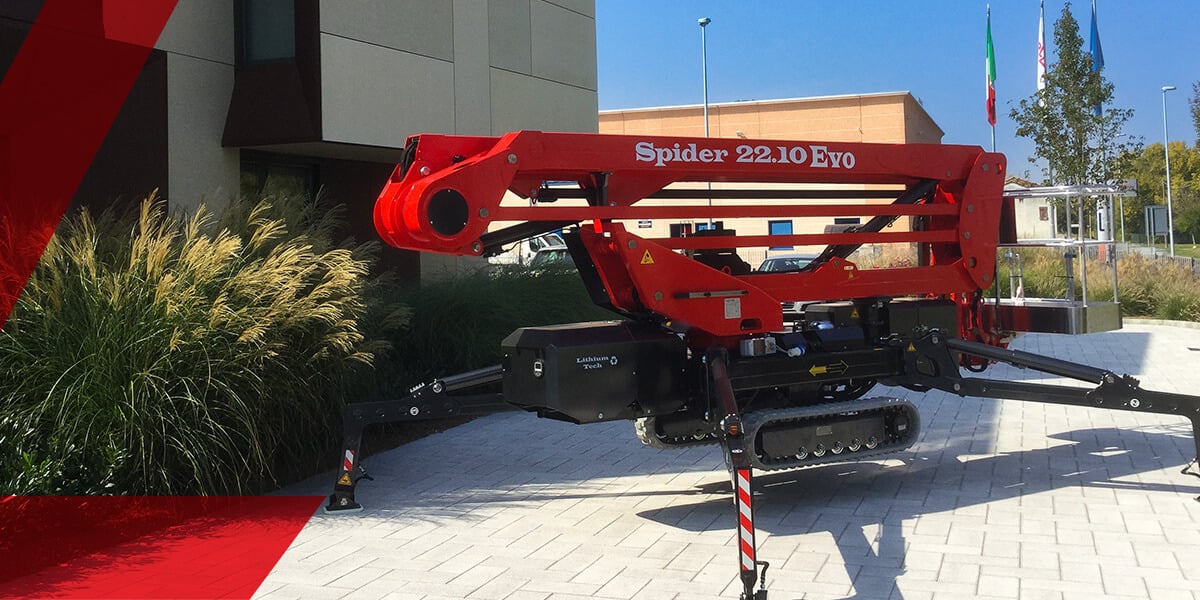As the weather changes and the leaves begin to fall, the daily or weekly outdoor maintenance of mowing, watering, & pruning flowers subsides and gives way to a different set of tasks. Homeowners, facility maintenance teams, and arborists alike begin to shift gears towards tasks that ensure homes, facility buildings, and their landscapes are prepared for the impending winter.
In this blog, we’re going to explore various fall landscaping, cleanup, and building maintenance tasks and how Platform Basket and OMMELIFT aerial lift equipment can be leveraged to make these tasks safer and more efficient.
Leaf Removal
One of the most prominent characteristics of the season is summed up in its name: falling leaves. According to a study conducted by the University of Washington, a mature oak tree will lose 200,000 to half a million leaves during the fall season. While some properties have just a few trees, others contain entire groves, substantially increasing the leaf count that will ultimately need to be attended to. It's not hard to see why leaf cleanup plays such a crucial role in fall property maintenance.
Why It’s Important to Remove Leaves From Buildings:
One of the most common places leaves can cause building damage is on gutters & roofs.
Gutters serve a crucial role by directing rainwater away from roofs, protecting both the building's interior and exterior, as well as the surrounding landscaping. A gutter clogged by leaves or other debris results in excess water accumulation, which in turn can lead to damage to the roof, walls, and foundation of the building and encourage issues like mold growth and pest infestations.
In addition to clogging gutters, leaf buildup on your roof can lead to a different set of damage. In a fall maintenance blog, Kearn’s Brothers explains how leaf buildup can threaten the integrity of your roof:
“A buildup of leaves on your roof traps moisture and prevents your shingles from getting dry. Shingles aren’t waterproof, in fact, they can start to form mold, and algae, create water damage, and rot the wood if exposed to too much moisture.
In short, leaving fallen leaves = problems with your roof system.
Additionally, leaving the leaves on your roof can create a dam that prevents water from traversing to your gutters. Or the leaves may wind up in your gutters, effectively jamming them up, and creating problems with gutters, fascia, and soffits.”
How A Tracked Lift Can Help With Cleaning Leaves Off Roofs & Gutters: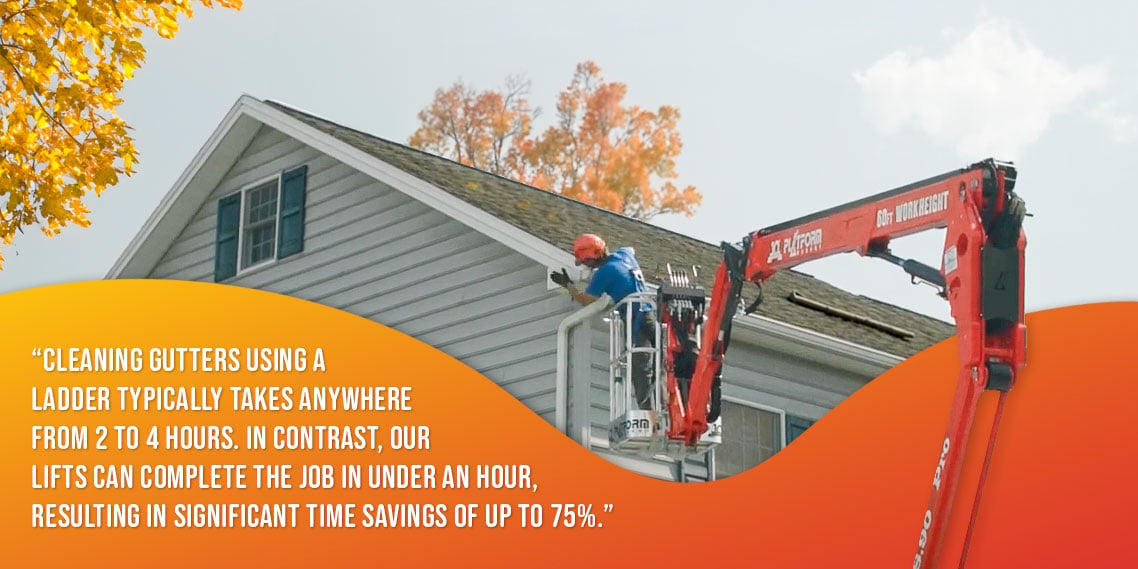
-
Safer: While an aerial lift won’t play much of a part in clearing ground leaves, it can certainly help you clean rooftops and gutters that pose a risk when leaves accumulate. Using a Tracked Lift to clean gutters and roofs is significantly safer than using a ladder to accomplish this task.
The Consumer Product Safety Commission reports that over 617,000 people are injured annually during fall cleanup activities and over 80,000 of those fall and get injured from gutter cleaning, requiring immediate medical care. Most of these serious injuries are in relation to the use of ladders, which we highlighted in our last blog.
Choosing to set aside your ladder and opting to use an aerial lift instead will significantly reduce your risk of injury or death from a gutter/roof-related task.
-
Faster: We have a range of lifts with working heights that vary from 60 feet to 121 feet, so we have roof and gutter cleaning solutions for buildings up to 10 stories. What sets our spider lifts apart is their notable side reach, extending horizontally up to 50 feet. To put this in perspective, an average two-story home is roughly 42 feet in length. Using a lift with a 50-foot side reach, like our Platform Basket 27.14 or our OMMELIFT 2750, would allow you to clean the entire length of your gutters without having to come down and reposition the lift.
In contrast, using a ladder would require you to climb down and relocate it roughly every 6 feet, considering your wingspan. This constant ladder adjustment can be quite time-consuming. Cleaning gutters using a ladder typically takes anywhere from 2 to 4 hours. In contrast, our lifts can complete the job in under an hour, resulting in significant time savings of up to 75%.
Is your roofline in a tight space? Our lifts can fit through a 36-inch garden gate, so the combination of the narrow frame and impressive side reach means access is rarely an issue.
-
More Convenient: Another way that a Tracked Lift stands out over traditional methods of leaf removal is the air/water and electrical hook-ups found in the basket of our spider lifts. These features enable you to easily connect compressed air or pressurized water from the ground, eliminating the need for extensive hoses, making this fall cleaning task a breeze.
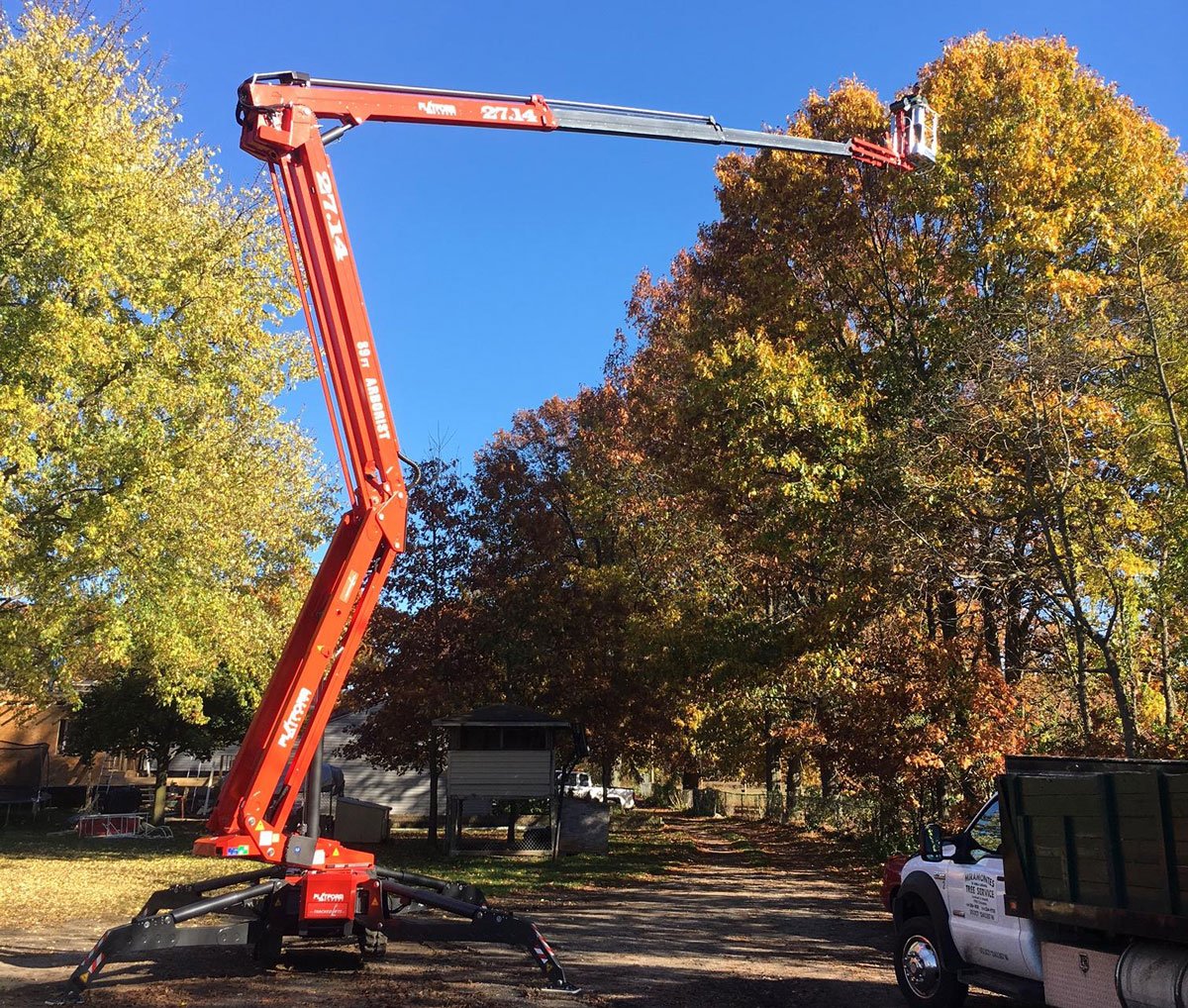
Tree Inspection and Pruning in the Fall for Property Safety
As the trees on a property become bare, you will have more of an opportunity to see dead branches or weak spots in the tree you couldn’t see when the foliage was thick. During the fall months, it is a good time to do a health inspection of all of the trees on a property, particularly those that crowd buildings.
If you don’t know what to look for, you might consider hiring a certified arborist to come out and do an inspection of your trees. If you do determine that you have tree maintenance that needs to be done, make sure you hire a professional to do large limb pruning or full tree removal, as this can be a dangerous job, even for trained professionals.
Why Is it Important to Trim Your Trees in the Fall:
Earlier we talked about the importance of keeping your gutters and roof clear of leaf pileups. Rather than dealing with the aftermath of leaf accumulation, trimming trees with branches hanging over your roof can greatly reduce or even eliminate the need to clear leaves altogether.
Another thing to think about is that for much of the United States, winter can bring storms with heavy winds, snow, and ice accumulation that can take a serious toll on trees, particularly when the structural integrity of a tree is compromised.
According to Caramanico & Sons Inc., a 4th generation family-owned and operated landscape company, trimming heavy branches on large trees in the fall can protect your property from winter storms:
“All it takes is one big storm to pile heavy snowfall on weakened branches. The weight can cause them to snap, and, depending on the size and location of your tree, these branches can fall and cause a lot of damage.”
They also highlight that pruning trees after their leaves have dropped is less stressful on the plant.
“Tree trimming during the summer can be problematic. Your plant is using its nutrients to protect itself against drought from heat, insect attacks, fighting infections, etc., and may already be in a weakened state. Your tree won’t deplete resources to heal when dormant.”
By taking proactive measures in the fall, property owners can mitigate potential hazards and enjoy a safer and more worry-free winter season.
How A Tracked Lift Can Help With Tree Pruning & Removal: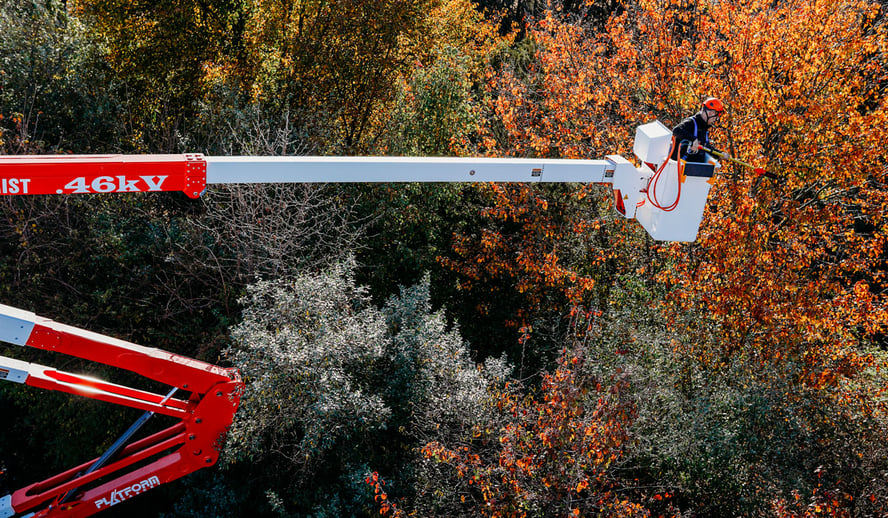
-
Purpose-built: Our purpose-built arborist lifts are designed with articulated boom sections that offer vertical, horizontal, and up-and-over movements, providing flexibility when navigating tree branches, buildings, or other obstacles. Platform Basket and OMMELIFTs can handle slopes up to 40% and are compact enough to fit through a standard man door, affording you access no other aerial machine can offer.
In both residential and commercial areas, arborists often face the challenge of trimming trees near powerlines, which can be extremely hazardous without the appropriate equipment. Our two insulated spider lift models, the Platform Basket 22.10 46kV and the OMMELIFT 2650 46kV, allow for the safe completion of tree trimming in close proximity to power lines.
-
Safer: According to the Tree Care Industry Association (TCIA), tree workers are slightly less than 0.05% of the entire U.S. workforce, but may account for about 1.4% of the work-related fatalities. Non-fatal injury statistics are even higher, with tree workers having about one fatal incident for every 14 non-fatal injuries.
“Climbers represent about half of all the fall incidents and most of the non-fatal ones. Either they fall from the tree or fall with the tree. Climbers fall from failed anchors – the branch their system was attached to breaks – or being unsecured, usually “just for a second” while they isolate a line or switch climbing systems.”
Aerial lift injuries are minimal in comparison and when incidents do occur, they are typically a result of the operator not wearing the recommended fall protection, or failing to attach their fall protection to their lift. When properly used, choosing a Tracked Lift for tree work significantly reduces the risk of falling compared to climbing
-
Easier & More Efficient: Features such as auto-level, like you can find on a Platform Basket 27.14, make setting up to do tree work quick and easy. In fact, our lifts can be set up from trailer to job site in as little as five minutes. As we mentioned earlier, our articulated boom sections make it possible to complete all or most of a job in one deployment.
As we know, the alternative to using an aerial lift for tree work is climbing, which can take a serious toll on the body. Using a Tracked Lift instead eliminates the need for continuous physical exertion, which reduces fatigue, and ultimately results in a job that is less physically demanding and requires fewer hours to complete.
Request an Equipment Quote for Your Fall Projects
At Tracked Lifts, we strive to offer our customers solutions that keep them safe, comfortable, and allow them to accomplish their needs efficiently. If you think you could use a Tracked Lift this fall, get in touch, and we’ll be happy to provide you with a quote.

